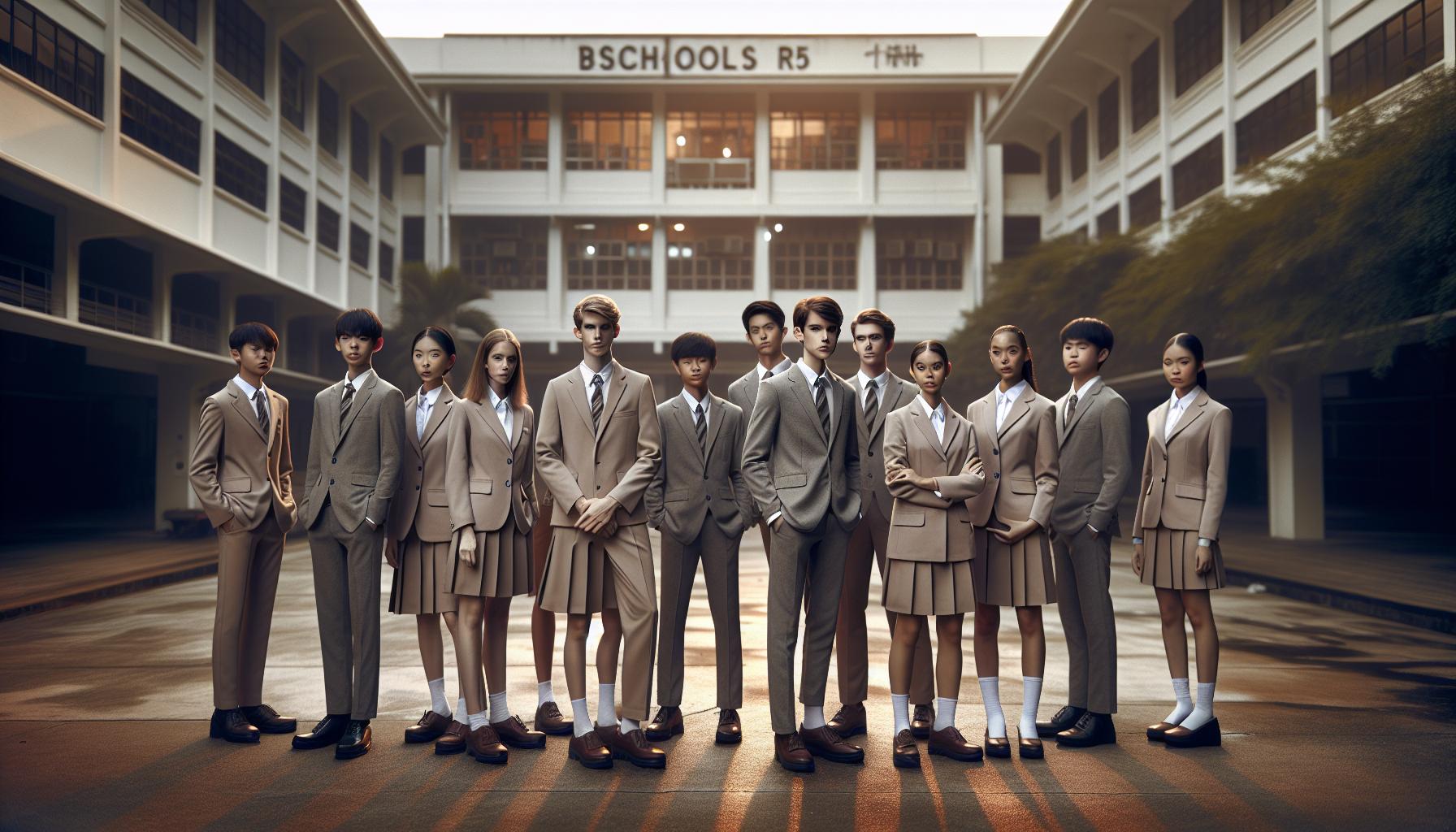In today’s educational landscape, the debate over whether students should wear school uniforms sparks strong opinions. Interestingly, schools that have adopted uniform policies have reported a 10% improvement in student punctuality, emphasizing the potential benefits of a simplified dress code. However, uniforms also raise concerns about freedom of expression and their role in social dynamics. As students navigate their identity and peer relationships, parents and educators alike wonder-do uniforms enhance community and focus, or do they stifle individuality? By exploring the pros and cons of school uniforms, we can better understand their impact on student life and academic performance, ultimately guiding families and schools in making informed decisions. Join us as we delve into this complex issue and unpack the multifaceted arguments surrounding school uniforms.
Benefits of School Uniforms for Students
Wearing school uniforms can fundamentally transform the educational experience for students, offering a range of specific benefits that extend beyond mere aesthetics. One of the primary advantages is the promotion of equality among students. With a standardized dress code, the distraction of varied fashion choices is minimized, allowing students to focus on their studies rather than peer pressure regarding attire. This sense of unity can foster a strong community environment within the school, where students feel a sense of belonging and pride in their institution.
Another key benefit of school uniforms is the potential for improved discipline and concentration. Research indicates that students who wear uniforms may exhibit enhanced focus during lessons, as uniforms often convey a formality that underscores the educational setting. This shift can positively influence behavior, with some studies noting an increase in student punctuality and reduced instances of distraction related to clothing choices[2[2].
Moreover, uniforms can streamline morning routines, reducing the time students take to dress for school. This efficiency may promote a more relaxed start to the day, which can positively impact overall student morale and readiness to learn. When students are not preoccupied with picking outfits, they can allocate their time to other important tasks, contributing to a more productive school day[1[1].
In addition to enhancing focus and discipline, uniforms can also play a role in safety. By making it easier to identify students who belong to a particular school, uniforms can help staff and security personnel monitor school grounds more effectively. This identifiable attire can help prevent unauthorized individuals from entering school premises, contributing to a safer learning environment[3[3].
Adopting school uniforms can cultivate an atmosphere conducive to learning, support equality, and promote safety – all vital elements in fostering a positive and effective educational experience for students.
Challenges and Drawbacks of Uniform Policies
Introducing a school uniform policy can come with a range of challenges and drawbacks that educators, students, and parents should consider before implementation. For many students, wearing a uniform can stifle their sense of individuality and self-expression. Clothing often serves as a canvas for personal identity, and for teenagers in particular, being able to express themselves through fashion can be a crucial part of their developmental journey. While uniforms aim to promote equality, they can inadvertently lead to feelings of frustration among students who feel that their personal choices are being restricted.
Financial implications also pose a significant concern. Although school uniforms may initially appear to save parents money by limiting clothing choices, the costs can add up, especially if families are required to purchase specific uniform items from designated suppliers. This can create financial strain for families already managing tight budgets. Additionally, uniforms may require students to buy multiple sets to accommodate laundry schedules, leading to increased expenses. In this way, the supposed cost-saving benefits can quickly diminish, especially for families with multiple school-aged children.
Another challenge involves the potential impact on school culture. While uniforms are designed to foster a sense of community and belonging, they can also lead to increased scrutiny and policing of students. For instance, if a school adopts strict guidelines about uniform compliance, it may result in unnecessary disciplinary actions for minor infractions, which can create a hostile environment rather than fostering cooperation. This monitoring can shift the focus from academic achievement to maintaining compliance, which can detract from the school’s mission of education.
Moreover, the effectiveness of uniforms in enhancing student performance is a topic of debate. While some studies suggest that uniforms can lead to improved behavior and focus, other research indicates that the psychological effect of uniforms may be minimal compared to other factors influencing student success, such as teaching quality and school resources. Thus, schools should weigh the advantages of a uniform policy against the potential consequences it may have on student morale and overall educational goals. By addressing these challenges, schools can navigate the complexities of implementing uniform policies while striving for an inclusive and supportive learning environment.
Impact of Uniforms on School Culture
The introduction of school uniforms often aims to create a sense of unity and discipline within a school community, but their impact on school culture can be profound, both positively and negatively. When students wear the same attire, it helps to level the playing field, minimizing socio-economic disparities and fostering inclusivity. This uniformity can lead to enhanced school spirit as students feel a sense of belonging and identity as part of a collective. Participating in a unified dress code can enhance feelings of camaraderie, making it easier for students to connect across various social groups.
However, the enforcement of uniform policies can instigate a level of scrutiny that may inadvertently create tension. When uniform adherence is strictly monitored, it can foster an environment of distrust between students and staff. Students might feel that they are being policed rather than supported, leading to potential rebellion against authority and a decrease in overall morale. For instance, schools with rigid dress codes may find that students frequently face disciplinary action over minor infractions, creating an atmosphere focused more on compliance than on learning or personal growth.
Moreover, uniforms can serve as a double-edged sword in terms of individuality. While they can reduce distractions and promote a more serious academic environment, they may also suppress students’ ability to express their personal identities. This is particularly significant during the developmental stages of adolescence, where self-expression is crucial for building confidence and personal identity.
In moving towards a balanced approach, schools can consider incorporating variations or allowances within uniform policies, such as designated days for non-uniform attire or allowing students to personalize their uniforms with accessories. This flexibility can strike a balance between fostering a united school culture and allowing students to express their individuality. Ultimately, schools should aim to cultivate an environment that promotes both unity and respect for personal expression, helping students thrive academically while maintaining a supportive and vibrant school culture.
How Uniforms Affect Student Performance
The question of how school uniforms influence student performance is a nuanced topic, often sparking lively debates among educators, parents, and students. Research indicates that the introduction of uniforms may lead to several positive outcomes, particularly by reducing distractions and promoting a more focused academic environment. When students wear the same attire, it can diminish the social pressures associated with clothing choices, allowing them to concentrate better on their studies.
One significant aspect of this is the psychological impact uniforms can have on student behavior and engagement. Uniforms may enhance feelings of belonging and school spirit, which can, in turn, boost motivation and academic performance. When students feel connected to their school community, they may be more inclined to participate in class discussions, join extracurricular activities, and take pride in their academic achievements. A study found that schools implementing uniform policies noticed improvements in attendance and reductions in behavioral issues, which are critical factors in academic success [[1]](https://pmc.ncbi.nlm.nih.gov/articles/PMC8775910/).
However, the effectiveness of uniforms on performance is not universal. Some evidence suggests that simply wearing uniforms doesn’t equate to higher grades or test scores. The mere act of donning a uniform does not address underlying issues such as teaching quality, school resources, or student support systems that are vital to academic outcomes [[3]](https://www.educationalleadershipdegree.com/frequently-asked-questions/do-school-uniforms-improve-grades/). This indicates that while uniforms can create a conducive learning atmosphere, they are not a standalone solution for improving student performance.
To truly enhance academic success, schools may want to consider a comprehensive approach that includes staff training, mental health support, and community engagement alongside the implementation of uniform policies. Engaging students in discussions about the role of uniforms can also empower them, helping them feel more invested in their education and creating a culture of respect and responsibility. Thus, while uniforms can contribute positively to the student experience, they should be part of a broader strategy to foster an environment conducive to learning and growth.
Parental Perspectives on School Uniforms
Many parents find themselves weighing the pros and cons of school uniform policies, pondering how these regulations affect their children and the overall school environment. One compelling reason many parents support uniforms is the belief that they instill a sense of discipline and responsibility in students. Research indicates that wearing uniforms can foster a sense of school identity and belonging, minimizing the emphasis on fashion trends and social status among peers [[2]](https://www.unr.edu/nevada-today/news/2013/school-uniform-study). This can ease the anxiety parents may feel about their children being judged or bullied based on their clothing choices, especially during vulnerable developmental years.
Another aspect that resonates with parents is the potential cost-saving benefits associated with uniforms. While the initial purchase of a uniform may seem expensive, many parents argue that uniforms ultimately prove to be more economical. Uniforms often require fewer pieces than casual clothing wardrobes, leading to lower overall spending on clothing throughout the school year. Additionally, since uniforms are designed for durability, they may last longer, thereby reducing the frequency of shopping trips needed for replacements or trendy fashion updates.
However, not all parents are on board with uniform policies. Some feel that such requirements stifle individuality and self-expression. This perspective highlights a critical concern: the importance of allowing children to explore their identities through their clothing choices. For these parents, the matter transcends economics and discipline; they view personal style as a form of self-expression that contributes significantly to a child’s confidence and self-esteem. Engaging in conversations about appropriate dress allows parents to address these feelings while still enforcing reasonable boundaries around school attire.
Ultimately, are diverse and deeply rooted in personal experiences and values. For those leaning towards the positive side, fostering a cohesive community and promoting equality among students are paramount. Conversely, those against uniforms advocate for the importance of self-expression and comfort in developing their child’s identity. Each viewpoint presents valid arguments, making it essential for schools to consider involving parents in the discussion to reach a balanced approach that satisfies both individual expression and collective identity.
Cost Analysis: Uniforms vs. Casual Clothing
The debate over school uniforms often hinges significantly on their overall cost compared to casual clothing. While some parents may initially view uniforms as an extra expense on their household budget, thorough analyses reveal that they can often lead to substantial savings over time. Purchasing a few uniforms can decrease the overall volume of clothing students need for school, streamlining their wardrobe and eliminating frequent shopping trips for trendy, ever-changing styles. This efficiency not only saves money but also reduces the stress of keeping up with fashion trends among peers.
Cost Breakdown
When evaluating costs, consider these factors:
- Initial Investment: Uniforms typically require higher upfront costs due to their specialized styles and designs. However, over multiple years, this cost can balance out, especially when compared to continually updating wardrobe pieces that become outdated quickly.
- Durability: School uniforms are designed for extended wear, using robust materials that can withstand daily use. In contrast, casual clothing might wear out faster, requiring more frequent replacements.
- Quantity Required: Many schools set uniform policies that limit the number of necessary items. For instance, while a casual wardrobe could require many outfits for different occasions, a standard uniform might only include four to six key pieces.
- Resale Value: Uniforms often have robust resale markets, particularly in communities with established private or charter schools. Parents can save by buying used uniforms, which further alleviates the financial burden.
A survey indicated that a staggering 76% of parents feel that the expenses associated with uniforms and supplies stretch their budgets, reflecting the economic pressures many face in providing for their children’s education [[1]](https://www.theguardian.com/money/2023/aug/19/back-to-school-do-uniforms-really-need-to-cost-a-fortune). However, as some parents have pointed out, a well-planned uniform policy can potentially reduce long-term clothing costs, aligning educational expenses more sustainably with family budgets.
In essence, while the cost of uniforms might seem steep at first glance, they can offer a more economical alternative compared to casual clothing in the long run. This aspect becomes crucial for families managing tight budgets, allowing them to focus less on clothing competition and more on academic achievement and personal growth. Balancing financial management with educational needs can ultimately empower students to thrive without the distraction of fashion pressures.
Alternatives to Traditional School Uniforms
In the ongoing discussion about school uniforms, parents, educators, and students often explore creative alternatives that strike a balance between self-expression and practicality. These alternatives can foster individuality while ensuring students still adhere to certain standards that promote a focused learning environment. Embracing alternatives to traditional uniforms can empower students to express their identities, cultivate a sense of belonging, and potentially reduce financial burdens associated with purchasing specific attire.
One popular alternative is the “Dress Code” Approach, which establishes guidelines for acceptable attire without mandating specific uniforms. This flexibility allows students to choose outfits that reflect their personal style while still adhering to standards of neatness and appropriateness. By specifying certain colors, patterns, or styles, schools can create a cohesive appearance among students without the rigidity of traditional uniforms, promoting a sense of unity while allowing for self-expression.
Another innovative solution is the “Mix and Match” Program, where students are provided with a limited selection of essential clothing items that can be combined in various ways. This method not only encourages creativity but also helps families manage costs, as purchasing a few versatile pieces can offer multiple outfit combinations. For example, a school might provide basic polo shirts and khaki pants, allowing students to mix and match these items, which promotes equality and reduces pressure to follow fashion trends.
Furthermore, Customizable Uniforms can be introduced where students choose logos, colors, or even styles that resonate with their interests or personal flair. This model allows schools to maintain a uniform appearance while catering to individual tastes, making students feel more comfortable and confident in their attire.
Additionally, Second-Hand Clothing Swaps offer another option for families looking to save money while promoting sustainability. Schools can organize events where students can trade gently used clothing, including uniforms or casual wear, fostering a sense of community and helping normalize conversations around budgeting and resourceful living.
By incorporating these alternatives, schools can cultivate an environment that values both unity and individuality, driving positive student engagement and emotional well-being. Approaches like the dress code or mix-and-match options not only reduce economic strain but also shift the focus from competition and fitting in to learning, growth, and self-acceptance. Ultimately, the goal is to create inclusive educational settings where students thrive academically and personally, irrespective of their clothing choices.
Case Studies: Schools with and without Uniforms
Across the globe, schools adopt varied approaches to uniform policies, each yielding different outcomes in student behavior, academic performance, and school culture. Examining case studies from both sides of the debate highlights how uniform requirements or the absence of them shape students’ everyday experiences.
In one notable example, a public high school in San Diego implemented a strict uniform policy mandating khaki pants and specific polo colors. Initially met with resistance, research conducted over three years revealed a significant drop in disciplinary issues and an increase in overall attendance rates. The administration noted that uniforms reduced peer pressure and distractions around clothing, creating a more focused learning environment. Students reported feeling a greater sense of belonging and less anxiety about fitting in, as everyone dressed similarly, which fostered camaraderie among peers.
Conversely, an arts-focused academy in New York City chose to forego a mandatory uniform policy in favor of a flexible dress code that encourages self-expression through fashion. This approach has led to mixed outcomes: while students express their individuality, the school encounters challenges with maintaining decorum during classes. Some instructors claim that students’ diverse styles sometimes distract from the instructional material. However, students voice that freedom in choosing their attire boosts their confidence and mirrors their personal identities, enhancing their overall school experience.
- Positive Outcomes from Uniforms: Improved attendance and reduced disciplinary actions.
- Benefits of Non-Uniform Policies: Enhanced self-expression and individual confidence.
Ultimately, the effectiveness of uniform policies often comes down to the specific community and culture of the school. Schools with uniforms generally report lower instances of bullying based on clothing choices, while those without uniforms often highlight increased creativity and self-expression. Finding a balance that supports students in feeling secure and valued, regardless of their attire, remains a critical goal for educators and administrators alike. This ongoing dialogue between maintaining order and encouraging individuality is central to shaping conducive learning environments.
Student Voices: Opinions on Uniform Policies
The debate surrounding school uniform policies often brings a kaleidoscope of opinions from students directly affected by these regulations. Many students express a mixture of relief and frustration when it comes to wearing uniforms. A common sentiment is that uniforms reduce the daily stress of deciding what to wear, potentially leveling the playing field among peers. For instance, in schools where uniforms are implemented, many students reported feeling less pressure to conform to fashion trends, allowing them to focus more on their studies rather than their outfits. This shared attire can foster a sense of belonging and unity, helping to mitigate the typical cliques formed based on clothing styles.
However, there is a contrasting perspective where students voice concerns over the loss of individuality. They argue that clothing is a key form of self-expression, which plays a substantial role in discovering and asserting their identities. In schools without uniform policies, students highlight the joys of showcasing their personal style, suggesting that it enhances their confidence and comfort in their learning environment. For these students, wearing what they love can be a significant part of their emotional well-being, and they worry that adhering to a uniform stifles this important aspect of their youth.
Student opinions also reflect their worries regarding peer bullying. While uniforms may help reduce bullying over clothing choices, they can inadvertently create new dynamics. For example, students in uniformed schools sometimes report being bullied by peers from non-uniform schools, highlighting the complex social interactions tied to attire. This reinforces the need for schools to create a positive social climate where respect and acceptance thrive, regardless of students’ clothing choices.
Ultimately, as schools continue to navigate the pros and cons of uniform policies, it’s vital for educators to actively seek student input when making decisions. Engaging students in discussions about their experiences and feelings not only empowers them but also ensures that policies reflect the needs of the entire student body. Whether through surveys, focus groups, or informal discussions, listening to student voices can lead to more thoughtful and effective uniform policies that balance individuality with community spirit.
Legal and Ethical Considerations of Uniforms
Navigating the terrain of school uniform policies involves understanding complex legal and ethical implications. One significant consideration is the balance between promoting a cohesive school environment and respecting individual rights. While many schools implement uniform policies to foster discipline and unity, these regulations must also align with students’ rights to self-expression. For instance, legal precedents highlight that dress codes must be carefully crafted to avoid discrimination based on gender, race, or religion, ensuring inclusivity for all students. In 2019, a notable case illustrated this point: a school dress code that disproportionately affected female students was challenged and led to a formal review of the policy.
Another critical aspect lies in the ethical considerations surrounding financial burden and access. Uniforms can represent a significant expense for families, particularly if schools require specific brands or styles. This creates an uneven playing field where students from lower-income backgrounds may feel excluded or marginalized. As such, schools should consider implementing policies that provide financial assistance or options for affordable uniform alternatives. Engaging parents and the community in discussions about the implications of uniform requirements can bring to light diverse perspectives and fosters a more inclusive environment.
To ensure that policies align with both legal requirements and student needs, schools can establish review committees that include student representatives. This participatory approach allows for a better understanding of how uniform policies affect the student body, promoting a sense of ownership and responsibility. Additionally, transparent communication about the reasons for implementing uniforms can help mitigate resistance, as students often respond positively to being involved in decision-making processes that impact their daily lives.
Ultimately, schools must tread carefully in enforcing uniform policies, ensuring they are fair, equitable, and responsive to the diverse needs of their student population. By adopting a nuanced approach that considers legal standards, ethical responsibilities, and community input, schools can create environments where uniforms serve their intended purpose without infringing on students’ rights or identities.
Global Trends: Uniforms in Education Worldwide
Across the globe, the debate surrounding school uniforms is influenced by cultural, social, and educational factors that vary from country to country. In many nations, uniforms symbolize a sense of community and equality among students. For instance, countries like Japan and the United Kingdom have a long-standing tradition of school uniforms, viewed as a way to promote discipline and unity while minimizing socioeconomic disparities among students. In Japan, school uniforms are not just clothing; they foster a sense of belonging and pride, while also preparing students for professional environments where appropriate attire may be expected.
Conversely, in the United States, opinions on school uniforms are increasingly divided. While some schools adopt uniform policies to enhance school spirit and reduce distractions, many educators and parents advocate for students’ rights to express their individuality through personal style. As a result, some schools promote dress codes rather than mandatory uniforms, allowing for flexibility within set guidelines. This approach aims to balance freedom of expression with the need for an orderly learning environment while reducing the financial burden often associated with standard uniforms.
Similarly, several countries in Africa are witnessing a growing trend of implementing uniform policies, particularly in public schools. In nations like Kenya and South Africa, uniforms are often seen as a means to improve both attendance rates and academic performance. Governments and NGOs collaborate to supply uniforms to disadvantaged students, addressing the financial hurdles many families face. However, the challenge remains in ensuring that these uniforms are affordable and accessible, a task that requires continued community and governmental engagement.
In contrast, some regions, such as parts of Europe and South America, reflect a more flexible stance toward uniforms in education. Countries like Sweden and Finland emphasize egalitarian principles in their schooling systems, where uniforms are less common. Instead, the focus is placed on fostering creativity and self-expression through personal clothing choices, which supporters argue better prepares students for diverse social interactions and self-management in their future careers.
Overall, global trends reveal a rich tapestry of perspectives on school uniforms. By understanding these varied approaches, educators and policymakers can learn valuable lessons about balancing community values with individual expression in the educational sphere. The continued evolution of uniform policies worldwide highlights the importance of addressing local cultures, needs, and academic goals to create environments that foster student success and inclusivity.
Tips for Implementing School Uniform Policies
Implementing school uniform policies can be a significant step toward fostering a cohesive and focused educational environment. Whether your school is considering this change or you, as a parent or educator, are advocating for it, understanding the nuances of implementation can make a difference. Here are some thoughtful strategies that can help ensure a smooth transition to school uniforms.
Start by engaging in open dialogues with all stakeholders, including students, parents, and educators. It’s vital to gather input and address concerns that may arise. Conduct surveys or hold meetings to gauge opinions and preferences-this not only promotes a sense of inclusion but also allows for the consideration of diverse viewpoints. For instance, understanding how uniforms might impact a student’s sense of identity can lead to a more empathetic approach in policy formulation.
Define Clear Guidelines
Clearly outline what the school uniform entails, including specific colors, styles, and any special considerations for different age groups. Make these guidelines easily accessible and straightforward to avoid confusion. Organizing information in tables can help; for example:
| Grade Level | Uniform Items | Notes |
|---|---|---|
| Elementary | Polo shirts, khaki pants | Comfort and ease of wear are priorities |
| Middle School | Button-up shirts, blazers | Encourage a more sophisticated look |
| High School | Formal blouses/shirts, dress slacks/skirts | Prepare students for future professional environments |
Educate students and parents about the benefits of uniforms, such as reducing distractions, fostering school spirit, and promoting equality. Hosting workshops or informational sessions can provide clarity on how these policies contribute to a conducive learning environment. Personal testimonials from students attending successful uniform schools can also bolster the uniformity argument.
Address Financial Concerns
Financial implications are a common concern when introducing school uniforms. Consider establishing a uniform assistance program that aids families in need, or partner with local organizations to provide affordable uniform options. Sharing the cost savings compared to casual clothing can also help alleviate worries; many families find that purchasing fewer clothing items that are specifically required often comes out cheaper in the long run.
Incorporating flexibility in your policy can also have a positive impact. For instance, allowing students to express individuality through specific accessories, such as shoes or backpacks, can help them feel comfortable while still adhering to the overall uniform standard.
By prioritizing transparency, inclusivity, and understanding, institutions can facilitate a transition to school uniforms that enhances student experience rather than hindering it. Keeping communication channels open and responsive also ensures that everyone feels valued in the journey towards this new policy.
Faq
Q: What are the main reasons schools implement uniform policies?
A: Schools often implement uniform policies to enhance student focus, reduce bullying related to clothing choices, promote equality among students, and create a cohesive school identity. These policies aim to minimize distractions and foster a positive learning environment.
Q: How do school uniforms affect student creativity?
A: Some argue that school uniforms limit self-expression and creativity, as students cannot showcase their individuality through their attire. However, proponents say students can express themselves in other ways, such as through accessories or personal interests, thus maintaining creativity outside of clothing choices.
Q: Are there any psychological benefits of wearing school uniforms?
A: Yes, wearing school uniforms can boost students’ self-esteem and sense of belonging. Uniforms can also create a professional mindset, helping students take their education more seriously, which may improve overall classroom behavior and academic performance.
Q: How can schools address concerns about uniform costs for families?
A: Schools can address uniform cost concerns by providing financial assistance programs, organizing uniform swaps, or partnering with local businesses for discounts. Engaging with parents and stakeholders can help create more affordable uniform solutions.
Q: What alternatives to traditional school uniforms do schools consider?
A: Alternatives include dress codes that allow casual wear with specific guidelines, themed clothing days, or uniforms that are less formal. Schools may choose options that encourage individuality while still maintaining a level of cohesiveness among students.
Q: Do uniforms really improve student discipline and behavior?
A: Evidence suggests that uniforms can lead to improved discipline and behavior, as they may reduce distractions and assert authority. Schools often report fewer disciplinary issues and better engagement when uniforms are enforced.
Q: What are the legal considerations regarding school uniform policies?
A: Legal considerations include ensuring that uniform policies do not discriminate based on race, religion, or gender. Schools should also consider exemptions for students with specific needs or beliefs. Clear communication and guidelines can help navigate these legal aspects.
Q: How do parents feel about school uniform policies compared to casual clothing?
A: Parental opinions are mixed; some appreciate the simplicity and reduced morning conflicts, while others feel it limits their children’s self-expression. Surveys and open discussions can help schools understand and address parental perspectives effectively.
To Wrap It Up
As we wrap up our exploration of whether students should wear school uniforms, it’s clear that the debate encompasses a range of perspectives. While many advocate for uniforms to foster unity and school pride, studies indicate that their impact on behavior and engagement may not be as significant as once thought[1[1][2[2].
Are you grappling with your own opinions or experiences? We invite you to dive deeper into related topics such as the impact of school culture on student success or explore effective strategies for school community building. Don’t miss out on joining our newsletter for ongoing discussions and insights about student life, academic success, and financial management. Share your thoughts below or check out our guides on preparing for academic challenges and managing finances effectively. Embrace the conversation and take the next step in navigating the school environment confidently!









